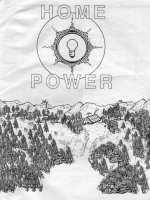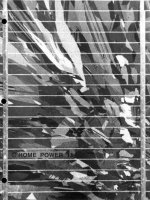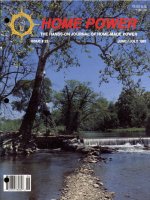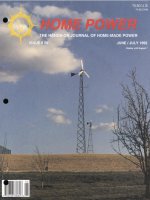home power magazine - issue 101 - 2004 - 06 - 07
Bạn đang xem bản rút gọn của tài liệu. Xem và tải ngay bản đầy đủ của tài liệu tại đây (12.83 MB, 152 trang )
BP Solar– setting the standard
for quality and performance.
the natural source for electricity.
®
Recognized as an industry leader for over 30 years, BP Solar
produces premium panels guaranteed to provide years of
superior performance. But a system is only as good as the
dealer who installs it. BP Solar’s precision engineering, record
field reliability and expansive product line is complemented by
the best distribution network in the business.
To start building a brighter tomorrow today, contact the
BP Solar dealer nearest you.
For more information, visit our website:
www.bpsolar.com/homesolutions
To learn more about our dealer programs
visit www.bpsolar.com/joinus
RECYCLED POWER
P
At U.S. Battery, we’re committed to doing our part in keeping the
environment clean and green for future generations, as well as
providing you with premium deep cycle products guaranteed to
deliver your power requirements when you need them.
Don’t settle
for anything less
than U.S. Battery
products!
Don’t settle
for anything less
than U.S. Battery
products!
1675 Sampson Ave. Corona, CA 91719 (800) 695-0945 / 653 Industrial Park Dr., Evans, GA 30809 (800) 522-0945
www.usbattery.com
The Sunny Central 125 kW
commercial solar inverter
is UL approved and
available now
What does SMA stand for?
Visit our website for dealer/installer support and training information.
SMA America, Inc. • 12438 Loma Rica Drive, Unit C • Grass Valley, CA 95945
Telephone: 1.530.273.4895 • Fax: 1.530.274.7271 • Email: • Web: www.sma-america.com
Simply More Amps
200,000 INVERTERS INSTALLED
INNOVATIVE TECHNOLGOY
TECHNICALLY ADVANCED
TRUSTWORTHY PARTNER
DEPENDABLE SUPPORT
20 YEARS EXPERIENCE
RELIABLE PRODUCTS
HIGH PERFORMANCE
HIGH EFFICIENCY
THE MOST KWH
SMA America’s Sunny Boy
available in 2500, 1800,
1100 and 700 watt sizes
RECYCLED POWER
P
At U.S. Battery, we’re committed to doing our part in keeping the
environment clean and green for future generations, as well as
providing you with premium deep cycle products guaranteed to
deliver your power requirements when you need them.
Don’t settle
for anything less
than U.S. Battery
products!
Don’t settle
for anything less
than U.S. Battery
products!
1675 Sampson Ave. Corona, CA 91719 (800) 695-0945 / 653 Industrial Park Dr., Evans, GA 30809 (800) 522-0945
www.usbattery.com
8
14 straw bale construction
Chris Magwood
The straw bale renaissance is gaining acceptance. Learn the good,
the bad, and the beautiful things about these energy efficient and
low-impact homes.
24 small town solar
Andy Kerr
Read about how Andy Kerr is living a carbon neutral lifestyle
thanks to solar electricity, solar hot water, and green tags.
34 solar profit
Andy Kerr
Andy Kerr’s business investments in solar technologies pencil out for
him. Take a look at his numbers to see how to profit from the sun.
40 pumping in Africa
Louis Woofenden
Louis Woofenden reports on an African water pumping project that
he managed—from fund raising, to system design and installation.
50 low head hydro
Jeffe Aronson
The Aronson family designed a low head hydro system that lives in
harmony with an Australian river’s ecosystem.
HP101
contents
8
9
www.homepower.com
Regulars
10 From Us to You
HP Staff
Renewable energy fair
s
educate, inspire
, and
keep it fun
.
110 Code Corner
John Wiles
PV basics affect the code.
114 Independent
Power Providers
Don Loweburg
Zero energy homes
and exposing anti-solar
hogwash.
118 Power Politics
Michael Welch
Coastal communities
challenge liquefied
natural gas terminals and
win!
122 Word Power
Ian Woofenden
Efficiency defined.
124 Home & Heart
Kathleen
Jarschke-Schultze
The chicken house of
mystery.
80 HP Subscription
Form
101 Energy Fairs
128 Letters to
Home Power
134 RE Happenings
138 Q&A
140 Readers’
Marketplace
142
Installers Directory
144
Advertisers Index
9
On the Cover
Author Chris Magwood
(see page 14) was one
of the builders of this
three-story straw bale,
post and beam home
in Ontario, Canada.
Photo by Catherine
Wanek.
60 tracker basics
Richard Perez
Tracking solar-electric modules can increase energy output by 25 to
40 percent. Find out if tracking makes sense for your system.
66 cabin power
Joshua Tickell
This solar powered getaway near Bogalusa, Louisiana, is a shining
example of off-grid peace, quiet, and comfort.
72 thermal trio
David Sweetman
David Sweetman’s system heats his home, domestic water, and pool.
This article proves that a solar thermal system can do more than
you might think.
82 REview
AJ Rossman
UpLand Technologies’ Energy Viewer—whole house AC monitoring.
88 hydrogen debate
Richard Engel & Dominic Crea
Hydrogen experts Richard Engel and Dominic Crea give us the pros
and cons of a hydrogen economy, then rebut each other’s statements.
96 inexpensive alternatives
Zeke Yewdall
Looking to cut energy costs, and lighten your electrical load and impact
on the planet? Check out Zeke Yewdall’s tips for frugal energy users.
106 hybrid vehicles
Shari Prange
Honda’s hybrid duo—the five-passenger Civic and sporty Insight—
reviewed by expert gearhead, Shari Prange.
from us to you
home power 101 / june & july 2004
10
10
Think About It
People who say it cannot be done should not interrupt those who are doing it.
–George Bernard Shaw, (1856-1950) Irish playright
and winner of the Nobel Prize for Literature 1925
Copyright ©2004 Home Power, Inc. All rights reserved. Contents may not be reprinted or otherwise reproduced
without written permission. While Home Power magazine strives for clarity and accuracy, we assume no
responsibility or liability for the use of this information.
Legal: Home Power (ISSN 1050-2416) is published bi-monthly for $22.50 per year at PO Box 520, Ashland, OR
97520. International surface subscription for US$30. Periodicals postage paid at Ashland, OR, and at additional
mailing offices. POSTMASTER send address corrections to Home Power, PO Box 520, Ashland, OR 97520.
Paper and Ink Data: Cover paper is Aero Gloss, a 100#, 10% recycled (postconsumer-waste), elemental chlorine-
free paper, manufactured by Sappi Fine Paper. Interior paper is Connection Gloss, a 50#, 80% postconsumer-waste,
elemental chlorine-free paper, manufactured by Madison International, an environmentally responsible mill based
in Alsip, IL. Printed using low VOC vegetable-based inks. Printed by St. Croix Press, Inc., New Richmond, WI.
HP staff
Publisher Richard Perez
Publisher &
Business Manager Karen Perez
CEO &
Technical Editor Joe Schwartz
Advertising Manager Connie Said
Marketing Director Scott Russell
Customer Service
& Circulation Shannon Ryan
Nat Lieske
Managing Editor Linda Pinkham
Senior Editor & Word
Power Columnist Ian Woofenden
Senior Research
Editor & Power
Politics Columnist Michael Welch
Art Director Benjamin Root
Graphic Designer &
Article Submissions
Coordinator Eric Grisen
Chief Information
Officer Rick Germany
Data Acquisition
Specialist AJ Rossman
Solar Thermal
Editor Chuck Marken
Solar Thermal
Technical Reviewers Ken Olson
Smitty Schmitt
Green Building
Editors Rachel Ware
Laurie Stone
Johnny Weiss
Transportation
Editors Shari Prange
Mike Brown
Home & Heart
Columnist Kathleen
Jarschke-Schultze
Code Corner
Columnist John Wiles
Independent Power
Providers Columnist Don Loweburg
HP access
Home Power, Inc.
PO Box 520, Ashland, OR 97520 USA
Phone: 800-707-6585 or 541-512-0201
Fax: 541-512-0343
Subscriptions, Back Issues, & Other
Products: Shannon and Nat
Advertising: Connie Said
Marketing & Resale: Scott Russell
Editorial Submissions: Eric Grisen
www.homepower.com
Everybody Loves a Fair
S
pring marks the beginning of this year’s energy fair
season. Each year, energy fairs introduce renewable
energy (RE) to tens of thousands of people in the U.S.
and around the world, and provide further education
to attendees already up on home-scale RE. They are big
fun too.
Nearly every RE festival has workshops, demonstrations, vendor exhibits, and
family activities covering a wide range of subjects. Topics include solar electricity
and hot water, microhydro and wind power, alternative vehicles and fuels, green
building, and a whole lot more.
The Home Power crew always looks forward to the energy fair season. It’s a
chance for us to hit the road and catch up with our readers, authors, and friends
in the industry. We’ll be attending many of the energy fairs this season, and
encourage you to attend your local fairs, and to support the hard-working groups
and volunteers that organize them.
For all the details of this year’s energy fairs, check out the events section at
www.homepower.com, and the Happenings section and energy fair ads in this (see
pages 101–105) and upcoming issues of Home Power.
See you at the fair!
–The HP crew
More Power per Sq. Ft.
More power–less installation space required
San
yo modules outperform the competition because they maintain higher volta
ges a
t higher temperatures – which means more power
and better performance!
• Approximately 5% higher power than other crystalline modules – providing a higher rebate in some states (per PTC ratings*)
• High efficiency HIT technology produces more energy per watt
Tha
t’s why SunWize GTS Grid–Tie Systems rely on Sanyo modules. Prepackaged systems are available from 1400 to 3000 watts. Visit our
web site, www.sunwize.com or call 800-817-6527 for more information.
*PTC stands for PVUSA T
est Conditions. PTC watt rating is based on 1000W/m
2
ir
radiance, 20º ambient temperatur
e and 1 m/s wind speed.
T E C H N O L O G I E S
SunWize
®
©2004 Chris Magwood
Photos by Catherine Wanek
home power 101 / june & july 2004
14
Straw Bale Building
On the Cusp of the Mainstream
Chris Magwood
©2004 Chris Magwood
Photos by Catherine Wanek
This two-family straw bale home in southern Oregon incorporates many other energy saving technologies,
such as solar hot water, rainwater collection, and photovoltaic panels.
The use of straw bales as a building material is reaching a very
interesting juncture, one that has many similarities to renewable
energy systems. Both straw bale building and renewable energy hold
tremendous promise—significantly lowering our impact on the planet,
without sacrificing most of the comforts we’ve become accustomed to
having. Both have been driven largely by passionate people willing
to do it themselves for practical and altruistic reasons. But the use
of renewables is ahead of the use of bales on the curve of public
acceptance, and bale builders can learn a lot from the development of
the renewable energy field.
Only twenty years ago, straw
bale building was virtually unheard
of. Although many of the successful
pioneer homes that were built with
bales 100 years ago in the Sand Hills
region of Nebraska are still occupied,
interest in the idea of creating new
buildings with bales only reemerged
in the 1980s. People looking to build
affordable, comfortable homes with
minimal impact on the environment
“rediscovered” this century-old idea
and began to reapply it in a modern
context.
Then, in 1994, a book by Steen,
Steen, and Bainbridge called The Straw
Bale House quietly began to introduce
the concept and more important, the
beauty of straw bale walls. The book
sparked a small revolution, and in
a decade, bale building went from
being a “fringe” concept to courting
mainstream acceptance. There are
now provisions for straw bale construction in the building
codes of several states, most notably in California, where
a well-funded testing program is helping to write a new,
state-of-the-art building code.
As with renewable energy, straw bale building enthu-
siasts can list all kinds of great reasons for adopting the
technology. Compared to standard wood framed walls,
bale walls offer much greater insulation value (figures vary
from R-37 to R-51) with a much lower environmental impact.
Enough straw is already produced in North America to
completely replace wood framing, saving millions of trees by
using an agricultural by-product that is harvested annually.
The building system can be very simple: the bales are
stacked like large bricks and capped with a wide wooden
beam. The bale walls are then plastered on the interior and
exterior, creating a wall system that is strong, resilient, and
very attractive.
The Good, the Bad, & Public Opinion
There are now thousands of examples of straw bale
houses in North America and around the world. Bale
buildings exist equally well in the harsh northern climate of
Alaska and the desert climate of Arizona, and in all points
between. In fact, there are bale buildings on every continent,
and in almost every country. Most of these homes, cottages,
and commercial buildings live up to the promise offered by
bale building.
But supporters of renewable energy know all too well the
pitfalls that can come with more widespread use of a new
technology; the variety of results and public perceptions is
very mixed. In the same way that a single, crumpled wind
generator tower can sully the reputation of hundreds of
functional installations, problems with a few bale homes
can dangerously color the perception of bale building by
contractors, code officials, and the general public. What
www.homepower.com
straw bale construction
15
Colored clay plaster with decorative bas relief adorns the
walls of this California home.
In load-bearing construction, a rigid “top plate” or “bond beam” is placed atop the
straw bale walls, joined at the corners and secured to the foundation. This beam
allows the weight of the roof to bear equally on all four structural bale walls.
Those big, thick bundles also cost a
lot less (in dollars and environmental
impact) than the equivalent amount
of any other insulation. Because they
can play a structural role as well as an
insulating one, bales are an attractive
and effective insulation.
This excellent, affordable thermal
performance attracts many people
to bale building. Several studies in
the U.S. and Canada have shown that
bale walls can help reduce heating
and cooling energy consumption by
25 to 60 percent. In a world where we
struggle to make very small dents in
our consumption, these figures are
inspiring.
But it is certainly possible to make
a bale home that is every bit the energy
hog as its neighbors. The use of straw
alone does not make an energy efficient house. Quality
windows and doors, proper insulation and construction
details at the top and bottom of the wall, and a good
plastering job are all necessary to make the walls work
effectively.
Attention must also be paid to properly insulating
foundations and roofs, since the best walls in the world can’t
contain heat that is escaping elsewhere in the building envelope.
Ignore some or all of these concerns, and those big, thick bale
walls won’t save you or the planet as much energy.
Environmental Impact
The construction world is currently being rocked to
its foundations by a new way of looking at the environ-
mental impact of building materials—embodied energy.
follows is an attempt to realistically address a number of
the questions that exist about straw bale building, and to
debunk some of the negative and positive myths that exist
regarding this building material.
Fire
Many straw bale skeptics are concerned about the
vulnerability of straw to fire. Straw bale supporters tend to
throw reports of the near fireproof nature of bale walls back
in response. The truth is, both sides have a point. Numerous
fire tests have been performed on plastered straw bale
walls, and all reports have shown outstanding results that
far exceed all residential code requirements.
Plastered bale walls can easily withstand a two-hour
fire test, outperforming almost all other wall systems.
However, loose and unplastered straw
is very susceptible to fire, and some
bale buildings have burned down in
the time between stacking the bales
and plastering them. So plastered bale
walls are indeed as resistant to fire as
supporters claim, but great caution
must be taken during construction to
avoid the kind of inferno that doubters
predict. This means cleaning up loose
straw around the building site and
avoiding smoking, welding, and
other spark producing activities near
exposed straw.
Thermal Performance
Supporters of bale building often
attribute a near mythic insulating
quality to straw bales. The fact is, straw
is only a moderately good insulator.
However, it happens to come in
bundles that are big and thick, so there
is lots of straw to do the insulating.
home power 101 / june & july 2004
16
straw bale construction
A straw bale wall has ideal qualities for passive solar design. The bales provide
insulation for the thermal mass of the interior plaster, which captures the warmth
of the winter sun through south-facing windows.
Straw bale pioneers Judy Knox and Matts Myhrman wrapped their concrete block
home with straw bales to increase its insulation against Tucson’s
intense summer heat.
Simply put, we are finally
starting to consider the cost
of a material to the planet,
in addition to its dollar
cost and its performance.
Embodied energy encom-
passes all of the processes
associated with producing
a material, such as the
energy required in mining,
transport, manufacturing,
administration, use, and
disposal. Seen in this light,
straw bales are an extremely
attractive option.
Since grain crops are
already being planted and
harvested, using the by-
product of this agricultural
activity means that straw bales are made with only minor
additional inputs of energy for manufacture (baling). The
embodied energy of straw bales has been shown to be 0.24
MJ/kg. MJ/kg is a measure of energy use (megajoules) per
kilogram (2.2 pounds) of material. So for every kilogram of
straw bale, 0.24 megajoules of energy was expended to create
it. Compared to 30.3 MJ/kg for fiberglass or 117 MJ/kg for
expanded polystyrene, it is obvious that remarkable gains
can be made in the reduction of energy use by redirecting
this material for construction use.
Even with these figures, it is possible to build a straw
bale house with an overall embodied energy that is
just as shockingly high as anything from conventional
construction. Often, bale homes are mistakenly built using
concrete foundations that are the width of the bale; all this
extra concrete (which has a very high embodied energy) can
negate any positive impact on the environment.
For a bale home to make good on its promise to help
the environment, the design of the home must minimize
embodied energy in all
phases of construction.
Earthen plasters, rubble
trench foundations, and
other strategies greatly
multiply the environmental
gains. Built thoughtfully,
bale walls can make a
big difference in environ-
mental impact. But slapped
into a building envelope
that otherwise doesn’t care
about the planet, bales won’t
save the planet.
Reliability
I always find it funny
when a building inspector
tells me that he doesn’t trust
these “experimental” building styles. Straw bale building
predates modern frame construction, with the earliest
examples dating from the turn of the last century. While
wooden framed homes share an equally long and proven
history, the modern frame home with its chipboard exterior
cladding, fiberglass insulation, plastic vapor barriers, and
drywall, has a much shorter history. In fact, we really don’t
know the life expectancy of a modern home. We do know
that simply built bale homes can last at least a hundred
years!
That said, it must be remembered that a poorly built
bale home will fall to pieces just as quickly as a poorly built
conventional home. In particular, skeptics will point to the
vulnerability of bale walls to moisture induced rotting.
They forget that straw and wood are very similar materials,
and that either material must be protected from moisture
penetration.
Moisture comes at our walls from all directions, and
for all of these, well proven measures can easily be taken.
While these moisture-proofing details
can be different for bale walls, most
are adaptations of the lessons learned
from mainstream construction, and
have been used to keep bale walls high
and dry for the life of the building.
Cost
Early proponents of bale building
extolled the low cost of the system,
perhaps overstating the case. Building
is never “cheap.” I tell potential
clients that buildings are expensive
or slightly less expensive, but never
cheap. While using straw bales and
plaster as a wall system can cost less,
the wall component of a building is
usually only 10 to 20 percent of the
overall cost. So at best, the bale walls
can reduce your overall budget by 5 to
www.homepower.com
straw bale construction
17
This Taos, New Mexico, home has monitoring probes in the
walls of the bathroom to keep track of humidity levels
in the straw.
The soft edges of straw bale walls help make this bedroom cozy and romantic.
10 percent. Less expensive components and labor strategies
must be sought at all phases of the project to make a real
difference in price.
Many modern bale homes do not rely on the simple
load-bearing straw walls of the pioneer examples. Instead,
they use some form of structural framework in which the
bales act only as insulation. Depending on the style and
complexity of the frame system, this kind of building can
easily be more expensive than its conventionally framed
equivalent. And even when using a load-bearing bale wall,
the unique labor and material requirements of this wall
system can raise the costs to the point where the savings
can be lower than originally anticipated.
Bales and plaster are fairly low cost items. But bale raising
and plastering involves plenty of labor, and it’s labor that
doesn’t come from a deep, knowledgeable, and competitive
pool, as is the case with framing. In fact, in my
own practice, we have found that the labor cost
of professionally raising bale walls is more
or less on par with the labor cost of framing.
Owner/builders of bale homes can certainly
save money using their own labor, but so can
owner/builders of any style of housing.
I don’t see this as a negative thing: a bale
home (R-37 to R-51) raised for the same cost
as a conventional home (R-12 to R-20) offers
its owner a significant reduction in ongoing
energy costs at a lower cost to the planet.
Most “green” products cost more than the
conventional products they replace. Bale
building right now costs the same, and the
price will only go down as the labor pool and
techniques develop, while lumber prices are
only going to get higher.
Learning & Growing Together
As with renewable energy systems,
sweeping, generalized statements about
straw bale building cannot be made. Yes, it
is possible to benefit from a whole range of
potential plusses, but it is equally possible to
overspend on a finished product that does not
perform to the level that is desired. Creating
a cost-effective, long lasting, and beautiful
bale home requires the same kind of study,
thoughtfulness, and skill as creating a good
renewable energy system.
Bale homebuilders benefit greatly from the
lessons learned by people in the renewables
business. We realize that sharing information
and being open and honest about our successes
and failures is fundamentally important. Strong
grassroots support systems, the creation and
circulation of valuable books and periodicals,
and the dedication of professionals who see
their work as a passion as well as a business—
these are things that bale building has borrowed
from the renewable energy field.
The passion for a greener future is common to bale
builders and users of renewable energy. In fact, a high
percentage of bale homes incorporate renewables. The
desire to create a more sustainable way of life is a strong
one, and people who share that desire tend to work
together to see it happen. Sure, there are differences of
opinion, but the direction is the same and the spirit of
goodwill is abundant and infectious!
Will everybody switch over to renewable energy and
straw bale building tomorrow? No—there’s a long way to
go before we’ll see that happen. The technologies need to
improve and be streamlined, capacities need to be grown,
and public relations must develop to create a wider demand.
But should everybody start moving toward building with
sustainable materials and using renewable sources of
energy? The answer is unequivocally, “Yes!”
home power 101 / june & july 2004
18
straw bale construction
The rocks at the bottom exterior of this Colorado home are a decorative way
to protect the earth-plastered straw bale walls from rain spash.
Access
Chris Magwood, Camel’s Back Straw Bale Construction,
RR#3, Madoc, Ontario, Canada K0K 2K0 •
• www.strawhomes.ca
Article photos by Catherine Wanek from the book, The
New Strawbale Home, Catherine Wanek, 2003, Hardback,
188 pages, ISBN: 1-58685-203-5, US$39.95, Gibbs Smith,
Publisher, Black Range Films & Natural Building
Resources, 119 Main St., Kingston, NM 88042 •
505-895-3389 • Fax: 505-895-3326 •
• www.strawbalecentral.com •
Books & videos about natural building
Straw Bale Details: A Manual for Designers and Builders,
Chris Magwood, with Chris Walker (Illustrator), 2003,
Paperback, 68 pages, ISBN: 0865714762, US$32.95 from
New Society Publishers, PO Box 189, Gabriola Island, BC,
Canada, VOR1X0 • 250-247-9737 • Fax: 250-247-7471 •
• www.newsociety.com
Straw Bale Building, Chris Magwood & Peter Mack, 2000,
Paperback, 235 pages, ISBN: 0865714037, US$24.95 from
New Society Publishers (see above)
The Last Straw Journal: The International Journal of Straw Bale
and Natural Building, Chris Magwood, editor, published by
The Green Prairie Foundation for Sustainability (GPFS).
PO Box 22706, Lincoln, NB 68542 • 402-483-5135 •
Fax: 402-483-5161 • •
www.thelaststraw.org
Serious Straw Bale: A Home Construction Guide for All
Climates, Paul Lacinski & Michel Bergeron, Paperback, 371
pages, ISBN: 1-890132-64-0 US$30 from Chelsea Green
Publishing Company, PO Box 428, White River Junction,
VT 05001 • 800-639-4099 or 802-295-6300 •
Fax: 802-295-6444 • •
www.chelseagreen.com
The Straw Bale House, Athena Swentzell Steen, Bill Steen, &
David Bainbridge, Paperback, 336 pages, ISBN: 0-930031-71-7,
US$30 from Chelsea Green Publishing Co., see above for
access
Building Official’s Guide to Straw Bale Construction, edited by
Kelly Lerner and Pamela Wadsworth Goode, (out of print
but under revision) California Straw Building Association
(CASBA), PO Box 1293, Angels Camp, CA 95222 •
209-785-7077 • •
www.strawbuilding.org
The Natural Plaster Book: Earth, Lime and Gypsum Plasters for
Natural Homes, by Cedar Rose Guelberth & Dan Chiras,
Paperback, 304 pages, 2003, ISBN: 0865714495, US$29.95
from New Society Publishers (see above)
www.homepower.com
straw bale construction
19
From a field of dreams
can rise your own healthy home.
For books and videos to help you make
your dream a reality
visit www.StrawbaleCentral.com
or call 505-895-3389 for a free catalog.
most grid-tied PV systems comes
when the power goes out.
Many homeowners are shocked to discover
that when the grid goes down, their grid-tied
PV
system goes right down with it. Even
owners of systems with battery backup
are finding that they’re paying for low
operating efficiency.
Now there’s a grid-tied, battery backup,
power conversion system that provides instant
power the moment an outage occurs . . . and
keeps it flowing at high efficiency levels day or
night, with the added benefit of an energy-
saving method of charging the batteries.
The Smart Power
™
M5 from
Beacon Power delivers 5kW of
power — enough to keep critical
loads running for hours or more.
And the transfer time is fast
enough to prevent most computers
from restarting. With all required
components integrated in one
compact outdoor-rated unit, the
Smart Power M5 is an effective solution for
lowering your electric bill and providing reliable
power during grid outages.
Available from: Alternative Energy Engineering, Dankoff Solar, Solar Depot, and SunWize Technologies
For complete information
on the UL-listed, California-
and New York-approved
Smart Power M5, contact
one of the distributors below,
or visit our Web site at
www.beaconpower.com.
technologies for welding and solar power generation. There are already over 60,000
Fronius inverters in operation all over the world.
The new FRONIUS IG 2000 and IG 3000 grid-tied inverters deliver higher reliability and
performance with a new high-frequency, phase-shifting architecture. This also cuts
weight to as little as 26 pounds, while integrated AC and DC disconnects help slash
installation time. The inherent higher efficiency of the IG Series is maximized with
intelligent thermal management to offer the highest performance available. Efficiency
you can verify with a large LCD display that provides both real time and cumulative
performance tracking.
So when it’s time for a new chapter in solar system performance,
talk to the people who wrote the book.
We wrote power conversion history.
Now you can get the condensed version.
P OWE RI NG YO UR FUTU RE
www.fronius.com
Grid-Tied Solar
In Small Town, USA
Andy Kerr
©2004 The Larch Company
Veteran installing dealer Bob-O Schultze of Electron Connection arrived to discuss
my long-fantasized solar-electric system. While I speak pidgin electricity and can
usually pound a nail straight, I knew that I didn’t have the skills, tools, or time to do
this job myself. Since it was the winter solstice, high noon, and uncharacteristically
sunny, the maximum shading at my site could be observed on the landscape. Bob-O,
who has lost count of the systems he has installed, would help me achieve my goal.
home power 101 / june & july 2004
24
Small town paradise, and carbon neutral too, thanks to conservation, solar thermal, photovoltaics, and more.
The goal of my family and
business is to be “carbon neutral”
so our activities do not contribute
to global warming. This is done by
conservation through using less fossil
fuel, switching to carbon-neutral fuels,
and mitigating carbon emissions that
we cannot presently avoid by paying
others to conserve, switch fuels, or
sequester carbon in vegetation. (See
the green tags sidebar.)
Of course, conservation and
efficiency were our first strategies.
Since moving into our Ashland,
Oregon, house in 1999, we have
installed a solar hot water system,
compact fluorescent bulbs, a Sun Frost
refrigerator, three Sun Pipes for natural
lighting, a Tamarack whole-house fan,
and three Natural Light solar powered
attic fans for cooling. All are quite cost
effective (see my article in HP86).
While we aggressively conserve
electricity, we suffer no hardship.
Assessing Our Demand
After completing most of those conservation measures,
a review of twelve months of utility bills determined our
annual load to be 6,011 KWH. Concurrent with the PV
system installation, I installed an electronic timer to switch
the electric water heater off when it was unneeded, so
household demand is now somewhat lower. Heating water
at 3 AM makes as much sense as leaving the car idling
because you need it in the morning.
Many modern appliances are not off when they say they
are off. Phantom loads are devices with a remote control, a
clock, or a wall cube (AC to DC power converter) that uses
some energy even when the appliance is turned off. I have
at least 34 phantom and always-on devices that draw a
combined minimum of 100 watts 24/7. It works out to be 876
KWH per year, or 15 percent of my annual load.
The devices include several Limelites, energy efficient
night lights (0.3 watts; 0.2628 KWH per year) that I don’t
unplug every morning, televisions, clocks, telephones, fax
machine, stereos, smoke detectors, and other devices that
either must be on to work or that need to be reprogrammed
after power outages. I have no guilt about these modern
conveniences since our household (which also includes
my business) uses 57 percent of the national average for
residences, and the majority of that is generated from
sunshine.
System Sizing
The sizing of my system was not based on demand, but
rather was a function of how many PV panels would fit on
the roof of the new detached garage. Anticipating this PV
project, I’d specified an extra underground conduit between
the garage and house during garage construction.
As Bob-O and I stood on the garage roof in late 2000,
we could see our shadows being cast to the north across the
alley and onto the neighbor’s fence. The City of Ashland’s
solar access ordinance precludes structures that cast more
than a 6 foot (1.8 m) high shadow on an imaginary fence
along the south property line of your neighbor.
Bob-O brought his Solar Pathfinder to produce a chart
that depicted vegetation and structures that would stand
between the PV panels and the sun. I would need this chart
later to document my tax credits, other incentives, and for
specific additional protections for solar facilities under
Ashland’s solar ordinance.
www.homepower.com
small town solar
25
Thirty-two Siemens SR100 photovoltaic panels generate about 85 percent
of the Kerr family’s electricity.
Sun Pipes
transmit sun-
light directly
into the house,
offsetting
daytime lighting
loads.









